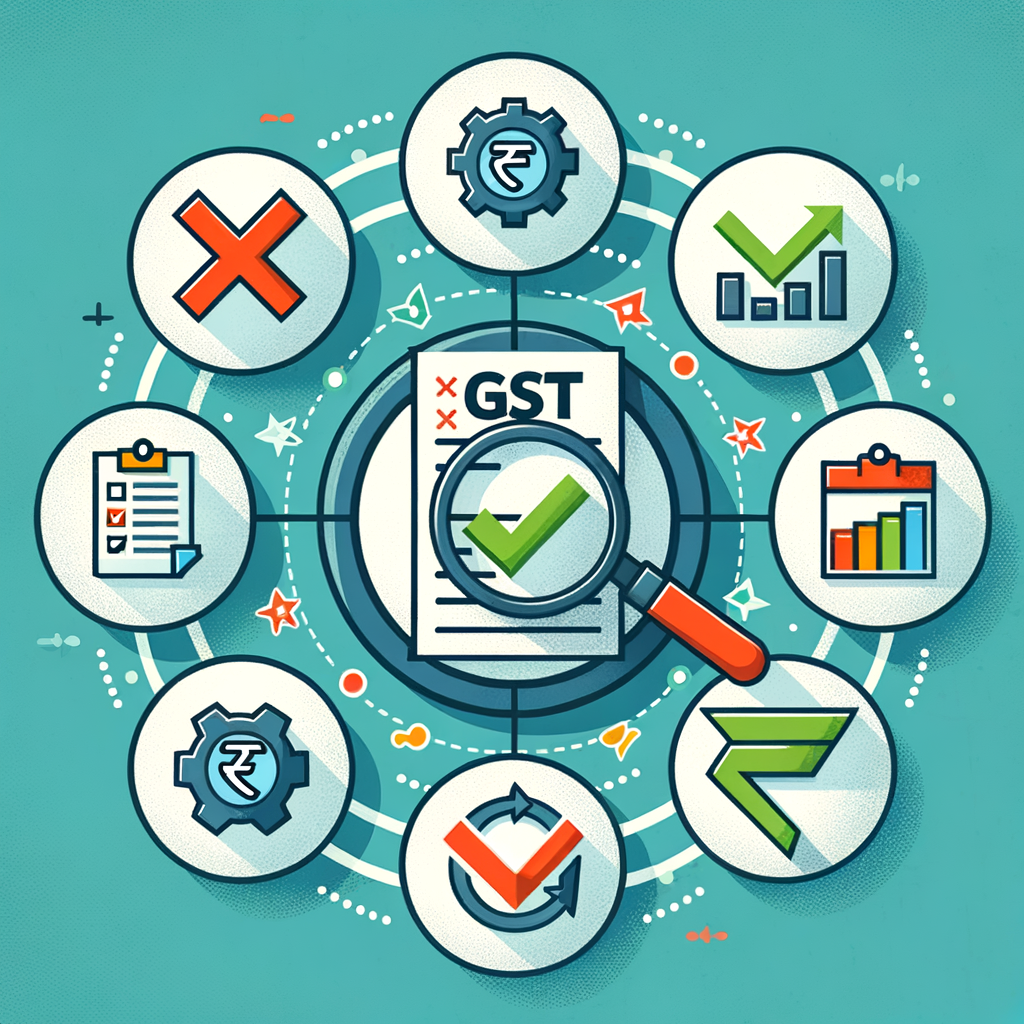Common GST Compliance Issues and How to Resolve Them
Meta Description: Facing GST challenges? Our guide details the most common compliance issues for Indian businesses, from ITC mismatches to late filing. Learn actionable GST compliance tips for Indian businesses to avoid penalties and stay compliant.
For many small business owners in India, navigating the Goods and Services Tax (GST) regime can feel like trying to solve a constantly evolving puzzle. While GST was introduced to simplify the indirect tax structure, its procedural complexities can be daunting. Dealing with these common compliance issues is a significant challenge, and even unintentional mistakes can have serious consequences. Non-compliance can lead to a cascade of problems, including hefty penalties, mounting interest, and unwelcome legal notices from the tax authorities, all of which disrupt your focus and drain your resources. GST compliance is not just a legal formality; it is a critical business function that directly impacts your cash flow, supplier relationships, and overall financial health. This article will break down the most frequent GST compliance challenges faced by businesses and provide practical, step-by-step solutions for resolving compliance issues for businesses in India, helping you stay on the right side of the law.
Understanding the GST Framework: The Foundation of Compliance
Before diving into the problems, it’s essential to understand the basic structure of GST, as most errors stem from a misunderstanding of these fundamentals. Mastering these core concepts is one of the most effective GST compliance strategies India can offer to a business owner. A solid grasp of how the tax is levied and classified is the first step in avoiding common compliance problems in India. This foundational knowledge empowers you to correctly categorize transactions, apply the right tax rates, and maintain accurate records from the very beginning, significantly reducing the risk of errors that can snowball into major issues later on.
The Basics: CGST, SGST, and IGST Explained
GST is a destination-based tax, meaning it’s collected by the state where the goods or services are consumed. To manage this between the Central and State governments, GST is divided into three components. Applying the wrong type of tax to an invoice is a surprisingly frequent and completely avoidable error that can complicate your filings and your customer’s ability to claim tax credits.
| Transaction Type | Location of Supply | Applicable Tax | Who Collects the Revenue |
|---|---|---|---|
| Intra-State | Within the same state | CGST + SGST | Centre + State |
| Inter-State | Between two different states | IGST | Centre (later apportioned to the destination state) |
| Import/Export | Into or out of India | IGST | Centre |
For example, if a business in Maharashtra sells goods to a customer also in Maharashtra, it will charge CGST and SGST. If the same business sells to a customer in Karnataka, it will charge IGST.
The Importance of Correct HSN/SAC Codes
Every good and service has a unique classification code under the GST regime. These codes determine the applicable tax rate and are crucial for uniform classification across the country.
- HSN (Harmonized System of Nomenclature) Code: Used for classifying goods.
- SAC (Services Accounting Code): Used for classifying services.
Using an incorrect HSN or SAC code can have a ripple effect. It leads to charging the wrong tax rate on your invoice, which can result in either over-collection or under-collection of tax. This not only creates disputes with your customers but also attracts scrutiny from tax authorities during audits, potentially leading to demands for the differential tax along with interest and penalties.
Actionable Tip: Always verify the correct HSN/SAC for your products or services. The official GST portal has a robust search tool for this purpose.
- Official Resource: You can find the correct codes using the GST Portal’s HSN/SAC code finder.
Top 5 Common Compliance Issues and Their Solutions
Now that we have the basics covered, let’s explore the most common compliance issues that businesses encounter in their day-to-day operations. This section provides a deep dive into how to resolve GST compliance issues, offering practical compliance troubleshooting for Indian businesses and guidance on navigating common compliance challenges. Understanding these pitfalls and their solutions is key to maintaining a clean compliance record and ensuring smooth business operations.
Issue 1: Input Tax Credit (ITC) Mismatch (GSTR-2B vs. GSTR-3B)
The Problem: One of the most significant challenges for businesses is the mismatch between the Input Tax Credit (ITC) available in their auto-populated GSTR-2B and the ITC they claim in their GSTR-3B return. GSTR-2B is a static statement that reflects the invoices uploaded by your suppliers in their GSTR-1. A mismatch occurs for several reasons: your supplier may have failed to file their GSTR-1 on time, entered your GSTIN incorrectly, reported an invoice with the wrong value, or you might have made a clerical error while recording the purchase in your books.
The Impact: The consequences are severe. The GST law now strictly mandates that you can only claim ITC that appears in your GSTR-2B. A mismatch means you lose out on genuine credit, which directly impacts your cash flow as your tax liability increases. This can also trigger notices from the GST department demanding an explanation and potentially the reversal of wrongly claimed credit along with interest.
The Resolution (How to Resolve):
- Reconcile Before Filing: The golden rule is to always reconcile your purchase register with your GSTR-2B before filing your GSTR-3B. This should be a non-negotiable monthly activity.
- Identify Discrepancies: Use accounting software or even a simple spreadsheet to compare your purchase records invoice-by-invoice against the data in GSTR-2B. Note down any missing invoices or invoices with mismatched values.
- Communicate with Suppliers: Immediately contact suppliers whose invoices are missing or incorrect. Politely but firmly request them to file their GSTR-1 or amend the details in their next return. Consistent follow-up is key.
- Use Technology: Manual reconciliation is time-consuming and prone to errors. Using accounting software with built-in GST reconciliation features can automate this process, saving you time and ensuring accuracy. Services like those offered by TaxRobo’s GST Services can manage this entire reconciliation process for you.
Issue 2: Incorrect or Delayed Invoice Generation
The Problem: The tax invoice is the most critical document in the GST ecosystem; it’s the primary evidence for a transaction and the basis for claiming ITC. Common invoicing errors include missing mandatory information (like GSTIN, HSN/SAC codes, place of supply), incorrect tax calculations (applying CGST/SGST instead of IGST), or failing to generate e-invoices within the stipulated time for businesses that cross the turnover threshold.
The Impact: An incorrect invoice directly harms your customer, as they will be unable to claim ITC based on a faulty document. This often leads to payment delays and can damage valuable business relationships. From a compliance standpoint, incorrect invoices can be flagged during audits, leading to penalties. For businesses required to generate e-invoices, failure to do so renders the invoice invalid, which can cause major disruptions in goods movement and payment cycles.
The Resolution (How to Resolve):
- Invoice Checklist: Ensure every invoice you issue contains these mandatory fields:
- Supplier’s Name, Address, and GSTIN
- Invoice Number and Date
- Recipient’s Name, Address, and GSTIN
- Correct HSN/SAC Code
- Description, Quantity, and Value of Goods/Services
- Applicable rate and amount of CGST, SGST, IGST
- Place of Supply
- Understand E-Invoicing: Be aware of the current e-invoicing turnover threshold. If your business is covered, you must generate an Invoice Reference Number (IRN) from the official portal for every B2B invoice. Integrate your accounting system with an e-invoicing solution to streamline this process.
- Official Guidance: For detailed rules on invoice formats, refer to the resources on the CBIC website.
Issue 3: Late Filing of GST Returns (GSTR-1 and GSTR-3B)
The Problem: This is arguably one of the most frequent common compliance problems in India. Despite clear deadlines, businesses often miss filing their GSTR-1 (statement of outward supplies) and GSTR-3B (summary return and tax payment) on time. This can happen due to poor financial discipline, a last-minute rush, lack of cash flow to pay the tax, or simply being unaware of the due dates. Learning How to File GST Returns Online: A Step-by-Step Guide of the GST Filing Process & Procedure can help prevent many of these delays.
The Impact: The consequences for late filing are direct and financial. The government imposes a late fee for every day of delay, for each return. More importantly, interest at a rate of 18% per annum is charged on the amount of tax that was not paid on time. Furthermore, continuous non-filing of returns can lead to the suspension of your GST registration and will block you from generating E-Way Bills, effectively halting your business operations.
The Resolution (How to Resolve):
- Know Your Due Dates: Mark your calendar. Due dates vary based on turnover and whether you are in the QRMP (Quarterly Return Monthly Payment) scheme.
| Return Type | Filer Type | Due Date |
|---|---|---|
| GSTR-1 | Monthly Filer | 11th of the next month |
| GSTR-1 | Quarterly Filer (QRMP) | 13th of the month following the quarter |
| GSTR-3B | Monthly Filer | 20th of the next month |
| GSTR-3B | Quarterly Filer (QRMP) | 22nd/24th of the month following the quarter (staggered by state) |
- Set Reminders: Use calendar alerts, accounting software reminders, or engage a professional who will manage these deadlines for you.
- Outsource for Peace of Mind: The simplest way to ensure timeliness and accuracy is to outsource your GST filings. A professional firm like TaxRobo treats your deadlines as their own, giving you the freedom to focus on your core business.
Issue 4: Confusion over Reverse Charge Mechanism (RCM)
The Problem: Under the normal mechanism, the supplier of goods or services collects GST from the recipient and pays it to the government. However, under the Reverse Charge Mechanism (RCM), the liability to pay tax is shifted to the recipient. Many small businesses are unaware of this and fail to pay GST on certain specified purchases, such as services from a Goods Transport Agency (GTA), legal services from an advocate, or services from an unregistered person.
The Impact: Failure to discharge your RCM liability is a serious non-compliance. Since you were supposed to pay this tax directly to the government in cash, it cannot be offset against your ITC. During an audit, tax authorities will raise a direct demand for the unpaid RCM tax, along with interest and a penalty for non-payment.
The Resolution (How to Resolve):
- Identify RCM Transactions: Be aware of common scenarios where RCM applies. Some examples include:
- Hiring a Goods Transport Agency (GTA) for freight.
- Receiving legal services from an advocate or a law firm.
- Services from a director of a company.
- Sponsorship services.
- Follow the Process: If you have an RCM transaction:
- You must prepare a self-invoice for the purchase.
- Report this liability in your GSTR-3B.
- Pay the RCM tax amount in cash (through your electronic cash ledger) along with your regular GST payment.
- In the same return, you can claim the amount of tax you just paid as Input Tax Credit (subject to normal ITC conditions).
Issue 5: Non-Compliance with E-Way Bill Rules
The Problem: An E-Way Bill is a mandatory electronic document required for the movement of goods in a vehicle where the value of the consignment exceeds ₹50,000. Many businesses either forget to generate the E-Way Bill, generate it with incorrect details (like vehicle number or invoice value), or fail to update it if the vehicle breaks down.
The Impact: The consequences of non-compliance with E-Way Bill rules are immediate and severe. If your goods are intercepted by tax officials during transit without a valid E-Way Bill, the vehicle and the goods can be detained or even seized. You will be liable to pay a heavy penalty, which can be as high as the amount of tax payable, to get your goods released. This not only results in financial loss but also significant supply chain disruption.
The Resolution (How to Resolve):
- The Simple Rule: Memorize this: If you are moving goods in a vehicle and the total value of the goods is more than ₹50,000, you need an E-Way Bill. This applies to both inter-state and intra-state movements (though some states have different value limits for intra-state). For a comprehensive breakdown, refer to our Guide to GST E-Way Bill Generation.
- Be Prepared: To generate an E-Way Bill, you need the invoice/bill of supply, details of the recipient, and the transporter’s ID and vehicle number. Keep this information handy before dispatching the goods.
- Use the Official Portal: All E-Way Bills must be generated on the official government portal.
- Official Portal Link: E-Way Bill System
Proactive GST Compliance Strategies for Indian Businesses
Resolving issues is important, but preventing them is better. Adopting proactive GST compliance tips for Indian businesses can save you from stress, financial loss, and legal trouble. Effective compliance issue resolution in India begins with a strong preventive framework.
- Maintain Meticulous Records: Good compliance starts with good bookkeeping, and Maintaining Accurate Accounting Records for Tax Purposes is the bedrock of this principle. Keep your sales invoices, purchase bills, expense vouchers, and bank statements organized and up-to-date. This makes monthly reconciliation and annual filing much easier.
- Conduct Monthly Reconciliations: Don’t wait until the due date to check your data. Make it a monthly habit to reconcile your GSTR-2B with your purchase records and your sales register with the data you will report in GSTR-1.
- Stay Updated: GST laws and procedures are amended frequently. Follow reputable sources like the official CBIC website or subscribe to newsletters from trusted tax experts like the TaxRobo blog to stay informed about important changes.
- Leverage Technology: Manual compliance is a recipe for errors. Invest in good accounting and GST filing software. It can automate invoicing, generate accurate returns, and provide reconciliation reports, drastically reducing the margin for error.
- Seek Professional Help: Managing GST compliance can be a full-time job. Hiring a professional is not an expense; it’s an investment in peace of mind and business continuity. Experts handle the complexities of compliance, ensuring accuracy and timeliness, which allows you to focus on what you do best—growing your business.
Conclusion
Navigating the GST landscape requires diligence and a clear understanding of its rules. The most common compliance issues, such as ITC mismatches, late filing of returns, invoicing errors, and confusion over RCM and E-Way Bills, can pose significant risks to any business. However, by embracing proactive management, maintaining organized records, and leveraging technology, these challenges can be effectively overcome. Remember, the key to seamless GST compliance is not just about fixing problems as they arise, but about building a robust system that prevents them from occurring in the first place.
Navigating GST can be complex. Don’t let compliance issues slow your business down. Contact TaxRobo today for a complete GST Health Check and expert assistance in compliance issue resolution in India.
Frequently Asked Questions (FAQs)
Q1. What are the penalties for late filing of GSTR-3B?
Answer: For late filing of GSTR-3B, a late fee of ₹50 per day (₹20 per day for nil returns) is applicable, subject to a maximum cap based on your turnover. In addition to the late fee, interest at 18% per annum is levied on the outstanding tax amount for the period of delay.
Q2. Can I claim Input Tax Credit if my supplier has not shown the invoice in their GSTR-1?
Answer: According to current GST rules, you are only eligible to claim ITC if the corresponding invoice is reflected in your auto-generated GSTR-2B. GSTR-2B is populated based on the GSTR-1 filed by your supplier. Therefore, if your supplier fails to upload the invoice, you cannot claim that ITC. It is crucial to follow up with your supplier and ensure they file their returns correctly and on time.
Q3. Is an E-Way Bill required for all goods transportation in India?
Answer: An E-Way Bill is mandatory for the movement of goods in a vehicle where the consignment value exceeds ₹50,000. This applies to both inter-state and intra-state movements. However, there are certain exemptions, such as the transport of perishable goods, LPG, and items specified in the annexure to the E-Way Bill rules.
Q4. How can a small business manage common compliance problems in India without a dedicated accounts team?
Answer: This is a common challenge for small businesses. The most effective approach is a combination of technology and professional expertise. You can use user-friendly accounting software for daily tasks like invoicing and expense tracking. For the more complex and critical tasks like monthly return filing, reconciliations, and annual compliance, it is highly advisable to outsource to a cost-effective professional firm like TaxRobo. This ensures accuracy, timeliness, and expert oversight without the cost of a full-time team, giving you complete peace of mind.



